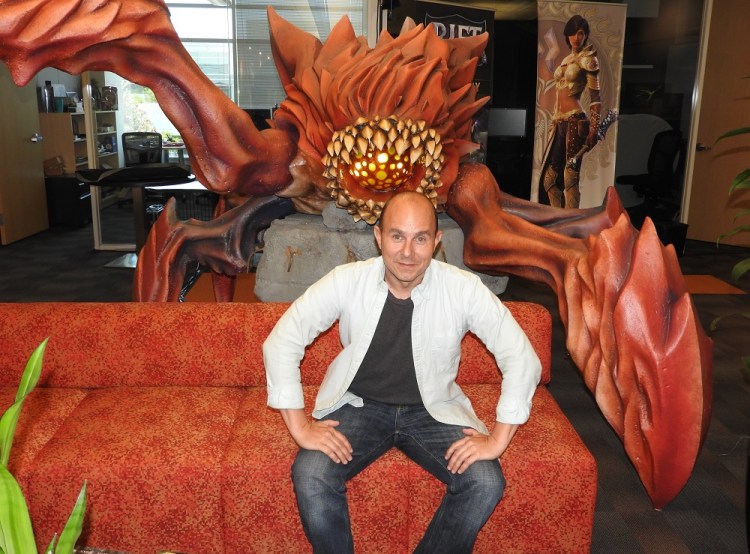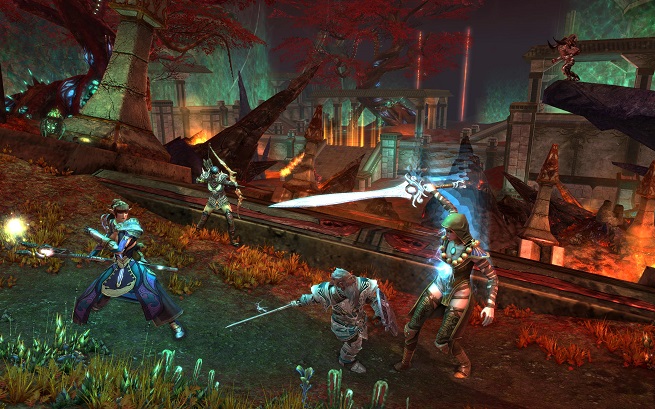GamesBeat: Has that been stable for a while? I know you used to have more.
Hartsman: It’s been growing over the last 14 months. The balance that you always want to strike — the goal for us is to run a healthy, stable, sane growing business. That’s what we’ve been doing. We’ve grown by maybe 50 people over the last year and a half.
When you look across the games industry, you see lots of peaks and valleys. I don’t think that’s good for the people who work in the games industry. It’s bad for human beings to never know if their job is stable, and it’s bad for companies to keep shedding their best talent. It’s bad for the industry because it makes the industry look like a place where people shouldn’t be working. Part of our goal over the last 18 months has been growing responsibly and becoming a place where, once people work here and they’re doing well, they can say, “I have a great job. I work with great people. I know the company’s looking out for me.”
GamesBeat: Any postmortem thoughts on Defiance?
Hartsman: Defiance was run out of our San Diego studio at the time. The thing that struck me was — the challenges they ran into were, they had a fixed date to hit because of the TV show. As soon as you have to sync dates with anything, you tend to then only have two other things that can give. You have scope and quality. The game itself did the actual gunplay better than anything I’ve seen in an online game. The place they tripped up was the sheer amount of scope they had to hit in a given amount of time.
There were elements of brilliance in there. The current team has refocused on the things that made Defiance really good and they’re pushing hard on those. The joy of shooting and collecting lots of guns and shooting stuff and the moment to moment fun of combat has always been solid. The current team has run with that.
GamesBeat: The kind of games you’re going after, are a lot of them examples of this east-to-west migration?
Hartsman: We actually have been talking to people in the U.S. for outside games. We’ve been taking our message as far and wide as possible. We’ve talked to a couple of companies in the U.S.
It’s still a costly affair to run your own MMO, even in the era of cloud computing. A lot of these systems, they’re not quite scaled. Cloud has scaled fantastically for asynchronous services like web services and synchronous services that are less intense. But the economics don’t quite make sense for hardcore server-based games. We’re taking that message to people here in the states, people in Korea, people in Canada. We’re talking to three or four companies in Europe. We’ve been talking to pretty much everybody.
GamesBeat: How do you spec the technology up a tier against some of the other ideas people are coming up with for cloud-related things?
Hartsman: The thing that we’ve learned the most about this — way back when people were first talking to me about Trion, they had a great tech for server-based AI and server-based gaming services. The thing that evolved over time was people realizing that we need to make sure all the tech we make is able to let people express fun. That was always the big challenge. The individual things that create fun in one genre to the next are very different.
A handful of companies have sprung up lately in cloud-based gaming services. I’m sure they have lovely tech. But the thing they’re all going to run into is making sure that their tech is enabling people to create fun, not getting in the way of creating fun. That was a big transition for us, prior to launching Rift. Trion had great server tech, but it was getting in the way of creating fun in different game genres. There was the balancing act of, okay, what should be common? What shouldn’t be common? What’s the domain of the game and what isn’t? I’ve been happy with where that balance has been for the last few years.
GamesBeat: You get the sense that there’s still some revolution to come in the cloud gaming world. There are startups like Improbable and Shinra Technologies. How do you look at some of those and whether your own technology is going to start evolving?
Hartsman: The mission is a little different. When you look at an Improbable — when I first saw what they were up to, I thought it was really cool. A lot of what they were describing outwardly was very similar to the Trion distributed backend that we currently run in our own games.
The places that we’re different, we pivoted very strongly into being a company that’s more focused on the games themselves than on tech. I can see a company like Improbable — this is just a guess — going off into trying to get as many developers signed up on their tech as possible. For us, we’re more focused on the games. The tech is just a means of delivering great games for us. We are definitely not looking to be the hardcore tech and get it out to as many developers as possible. We’re looking for games we can bring onto our platform if we have tools that can help make the creation of those games easier.
GamesBeat: Internally, have you talked about how many games you’ll be making at any given time?
Hartsman: There’s been a lot going on. One of the things we’ve been working out is exactly that, the right number of games for us to be working on at a given time for the amount of people we have and the bandwidth we have to do a triple-A job on all of them. That’s a constant push/pull for us.
Right now we have four games out, plus adding Devilian. We’ll have more games to announce next year, more games to announce in the future. The trick is to be sure we’re able to grow smartly so we can service all those games. It comes down to, what is the right amount of effort required to do any individual game at quality? Can we sanely grow to support that new capacity? I can see this scaling all the way up to a dozen games, two dozen games, three dozen games over time. But we want to scale up responsibly and scale up in a way that’s going to create successes.
GamesBeat: Those four games, that’s Rift, Defiance, ArcheAge, and Trove?
Hartsman: Yeah, those are the four so far.
GamesBeat: Do you have a launch window for Devilian?
Hartsman: We’re aiming for this year. Even though it’s pre-alpha, it’s shockingly playable right now in our English version.
GamesBeat: Did you have any opinions on E3 at all this year, about the competition or anything else?
Hartsman: The thing that struck me is, if you looked around — even though there are more of the traditional boxed game-makers making more online features, you probably didn’t see quite as many online games there.
It was the best E3 I’ve seen in a long time. I was excited as a player about all the games. I played a crapload of games. The thing that you see over time, though, is that those of us doing purely online businesses – we don’t do retail, we’re intentionally all online — a lot of the time our strategy is more around going to customer events and making sure we connect with consumers.
We weren’t officially at E3. We were there for meetings, but we didn’t have a formal presence because for any given amount of money we spend, we’d rather — we did PAX East. We’re doing PAX Prime. We’re doing Gamescom. We’d rather spend our time connecting with customers directly.
GamesBeat: They had the 5,000 gamers. But they’re still not quite….
Hartsman: So many of these things are popping up that you could spend your entire career doing nothing but going to consumer shows. You’d be busy all year round.
GamesBeat: The MOBA craze is still showing its influence. Halo 5 looks very MOBA-like in some ways. The shooter-MOBA goal is out there for a lot of folks.
Hartsman: Yeah. I saw Battleborn, saw Gigantic, saw Overwatch. There’s a lot of great gameplay in all three of those games. I’m looking forward to seeing how people react to them for real. I’ll personally play the hell out of all of them. But the classic MOBAs, obviously, you’ve seen how dangerous that market can be. There have been games that have shut down that were perfectly fine games. It’s just that the audience playing those MOBAs is happy to play the games they’re currently playing. They don’t want to move at all.
GamesBeat: Yeah, like the Warner Bros. and DC title, Infinite Crisis (which shut down).
Hartsman: Dawngate as well. I enjoyed Dawngate a lot.
GamesBeat: Is there any influence that you can take from MOBAs?
Hartsman: Session time is our big one. In the games we make, the amount of time that people want to play in a given session is increasingly important. You can include Hearthstone in this, too, because Hearthstone also uses an even more compressed session time for its genre. That’s been something we’ve internalized as we’ve gone into future development — games that we have in development, games we’re prototyping.
Your casual players will gladly come online and they expect to have a significant amount of fun in an atomic game unit of five to 30 minutes. Your hardcore users will just do that 10 to 20 times in a day. The big thing that’s shown is, hardcore gamers are absolutely open to five, 10, 15, 20-minute gameplay. That’s great. To me that’s a device that lets us expand the audience.




